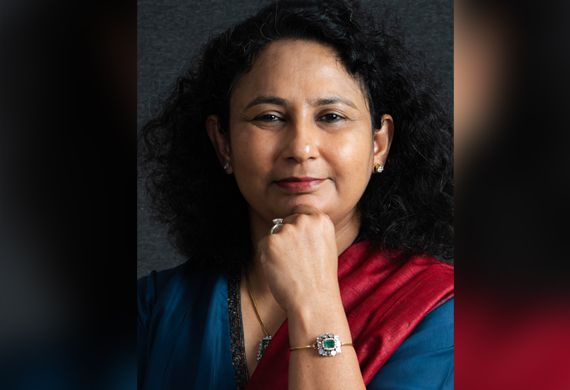
Role of Effective Communication in Brand Building
By: Minari Shah, Director, Amazon
Minari Shah brings to the table 30 years of experience in various communications roles, including copywriting, public communications, and corporate communications. She has worked at leading Indian publications and Amazon, where she served as PR head for India and corporate communications for Asia Pacific.
In a conversation with Women Entrepreneurs Review magazine, Minari expresses her passion for the power of communications to make a tangible difference in organizations' perceptions and advocates for communications as a strategic partner. She believes in creating content that balances corporate messaging with high credibility. She also speaks passionately about mentoring women for leadership and building leaders for the future.
How can industry leaders integrate communications more effectively into the core strategic planning processes of their organizations to drive both brand reputation and business outcomes?
How a company is perceived is becoming more important than ever before for its success, making communication increasingly important. A company's brand reputation must be a part of its strategic process, not an afterthought. Companies can make a significant difference in decision-making by having communications as part of the leadership team. This means that corporate communications are the custodians of Brand reputation, rather than just product launches or announcements, and have the responsibility for an ongoing process of building stakeholder trust. It is therefore key to every stakeholder in a company, including employees, policymakers, regulators, vendors, partners, logistics, and more. Finally, it is important that the communications leader reports in to the CEO/ MD who has broader visibility to all key plans, issues, and demands in the business and overall ownership for reputation.
How can industry leaders effectively address the challenges posed by the blurring boundaries between different audience segments, ensuring targeted and impactful communication strategies?
The modern world is characterized by overlapping audiences, including customers, investors, policymakers, employees, and vendors. These audiences interact on platforms like social media, and their perceptions are influenced by all the different channels. Leadership teams must recognize that they can no longer divide messaging for audiences, and all messages must be cohesive, to resonate and align with each other. Of course, companies can and must consider different channels of communication to effectively communicate these messages across audiences but must realize how they all play out with each other – for instance, the employees' perceptions of the company are influenced by media coverage and social media platforms. To plan a clear channel of communication for all audiences, it is crucial to strategically analyze the company's values, key issues, and messages, to build a clear messaging narrative and then plan ongoing channels of communication.
How should communications strategies evolve to adapt to the changing habits of content consumption, particularly with the rise of short-form content and the decline of traditional media consumption?
Companies must adopt a holistic content and channel strategy, addressing all audiences across various channels and media. Traditional media, user-generated content, influencer content, owned content and social channels like Instagram and LinkedIn are all important. Companies should focus on a singular view of earned, paid, and owned media, ensuring messages resonate and not over-index on one or the other. In a dynamic environment, companies may choose to rely more on one media over another for a particular campaign or for a period of time but over the long term, it must be well-balanced. This cohesive media mix must be backed with constant audit and monitoring of all these channels. The ROI from each channel should be measured, including monitoring whether the message is reaching the intended audience. Building strong monitoring and measurement mechanisms and a feedback loop are crucial for continuous improvement.
How can future communication leaders be mentored to embrace fearless experimentation and impactful outcomes, prioritizing skills needed to thrive in a rapidly evolving media landscape?
As I mentioned earlier, communication professionals need to build a more holistic strategy that considers internal, owned, earned, and paid media. They should not limit their responsibilities to product launches, announcements, press releases, or media conferences.
They have a strategic role in brand reputation and should speak out to company leadership about the ground reality, addressing challenges and providing solutions.
Communication leaders should be fearless in speaking out and showing a mirror to business leaders, especially where there is a change needed to enhance or manage the company's reputation.
They should also be aware of the pros and cons of new technology, such as AI, and ensure they understand their potential benefits and challenges or repercussions (for instance understanding issues of data security, privacy, etc.).
Finally, communication leaders must be focused on impactful outcomes rather than just the volume of coverage or big headlines. It is about finding the right mechanisms to consistently build needle-moving campaigns. This requires strategic planning, influencing business leadership, and looking at the broader bigger impact through a full mix of content channels.
Messages to Readers
One, People should recognize the importance of building strong domain and functional skills, and continuously upgrading them with new technologies and features.
Two, at the same time, there must be a focus on intentionally developing leadership skills, that go beyond being a good PR or communications professional, to learn what makes an effective and strong leader.
Three, I would emphasize the importance of having interests beyond work – it could be anything: fitness, food, movies, reading, etc. Having a broader outlook on life and having multiple interests can make a significant difference in one's life. So these are the three essential aspects of personal growth: continuously updating functional skills, intentionally developing leadership skills, and having a life outside of work.


.jpg)



